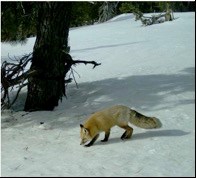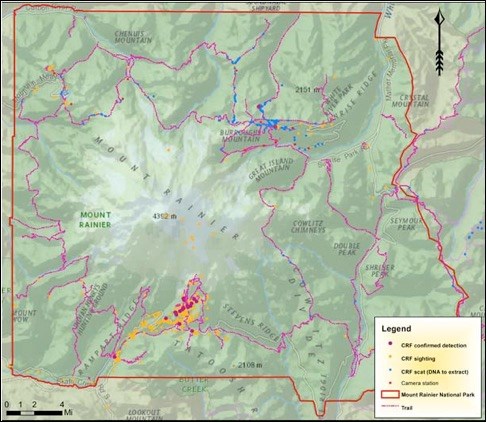Last updated: August 8, 2017
Article
Conservation Status of the Cascade Red Fox

Importance
The Cascade Red Fox is a Washington Candidate Species for protection and Natural Heritage Critically Imperiled Species. It is endemic to Washington where it is restricted to the upper mountain forest, subalpine parkland, and alpine meadows of the Cascade Range. The ancestors of this subspecies of red fox migrated across the Bering Landbridge into North America during the Illinoian glaciation over 300,000 years ago. During the most recent (Wisconsin) glaciation, the foxes were pushed south of the icesheets into ice-free forest refuges in what is now North America’s midwest. There, they presumably adapted to the colder, glacial climate, which lasted for approximately 100,000 years and they became genetically and morphologically distinct. When the Wisconsin icesheets receded, the foxes migrated into the mountains where conditions were similar to the glacial period. These foxes prey on small mammals and birds unique to the mountains and thus have an ecology distinct from lowland red foxes. The volcanoes of the Cascade Range appear to act as islands of habitat in the sky for small and isolated Cascade Red Fox populations. The low-elevation forest may as well be the ocean and it is unknown whether the foxes move between these sky islands. Recent surveys for the Cascade red fox and other carnivores suggest a precipitous loss of population abundance and distribution of this unique carnivore.This decline may be caused by changes to their mountain home including habitat loss and alteration due to climate change, widespread mid-elevation timber removal, and increased winter recreation that provides pathways into alpine areas for less snow- adapted predators and competitors such as the coyote and non-native, lowland red foxes. Many species that live at high elevation in the Pacific Northwest, such as the Wolverine and Pika, are of particular conservation concern due to their unique evolutionary histories and their sensitivity to climate change. They serve as indicators of future changes that will eventually affect more tolerant species and as such, make good models for conservation under changing climatic conditions. The Cascade red fox is such species.

Status and Trend
Historically, the Cascade red fox was distributed throughout the Washington Cascade Range. However, during the past several decades, studies in the North Cascades Ecosystem surveying forest carnivores such as Wolverine, Canada Lynx, Grey Wolf, and other boreal species have yielded only a few fox detections. The Cascade Red Fox appears to have suffered precipitous declines in distribution and abundance and some populations may have gone extinct. It occurs at low abundance throughout Mount Rainier National Park (see map), at sites on the Gifford Pinchot National Forest, and as sparse detections in the North Cascades Ecosystem. Its status in the remaining historic distribution is unknown and a general lack of information is hindering conservation efforts.
Discussion
Much of what we know about the Cascade red fox is understood from research conducted at Mount Rainier National Park. The Cascade red fox has been known to visitors of the park for over 100 years. The park provides excellent habitat for the fox and ample prey such as pocket gopher, snowshoe hare, songbirds, and huckleberries. However in the Paradise region, these carnivores are food habituated and susceptible to vehicle collisions due to their begging. This is a significant threat to a species that occurs at low abundance.
The Cascades Carnivore Project has been monitoring Cascade red fox populations since 2008. During 2011 and 2012, surveys were conducted at several sites in the park to collect fox scats samples for DNA analysis. This research will help to assess the connectivity of Mount Rainier foxes with other populations in the Cascade Range and determine the prospects from their long-term persistence. Preliminary results suggest that the Mount Rainier foxes represent a small and potentially isolated population.
To identify a Cascade red fox: They have a variety of coat colors from deep red to tan to black. It can always be distinguished from other canines by its white-tipped tail.
